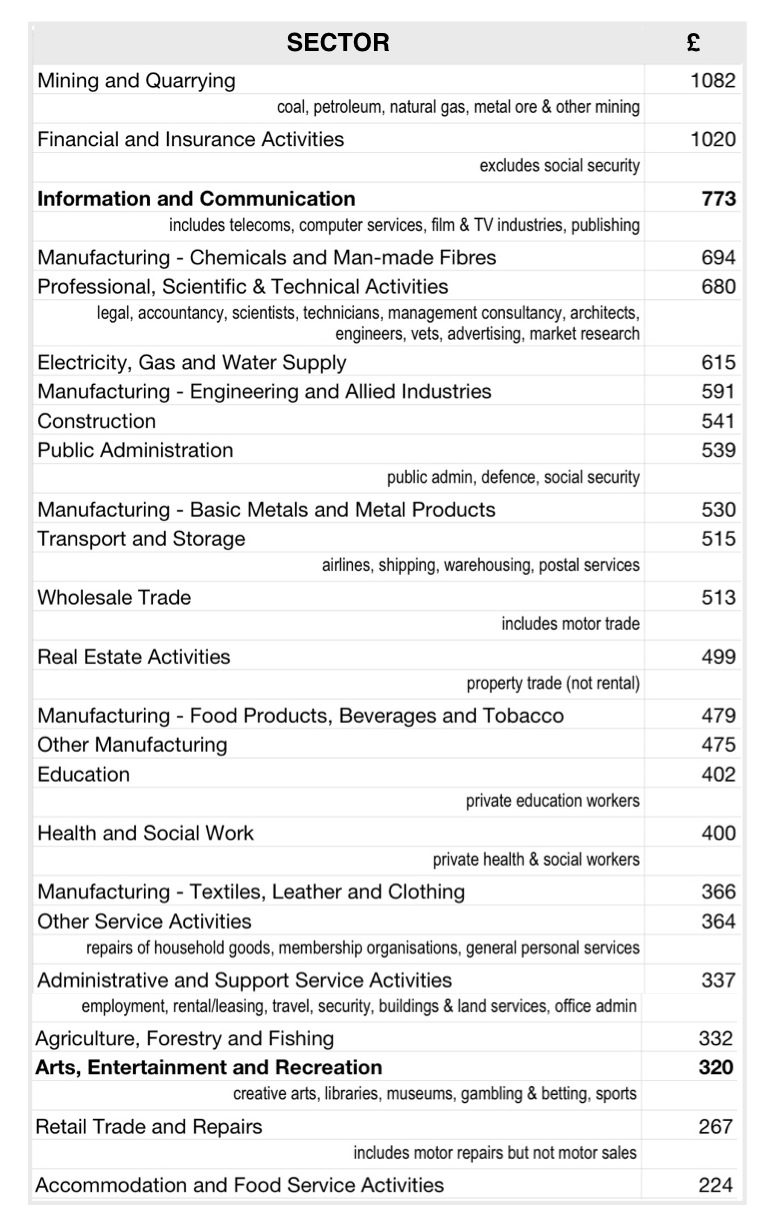Put your daughter down a mine, Mrs Worthington, say new earnings stats | reviews, news & interviews
Put your daughter down a mine, Mrs Worthington, say new earnings stats
Put your daughter down a mine, Mrs Worthington, say new earnings stats
2011 official statistics reveal arts are still almost at bottom of earnings pile

Don’t put your daughter on the stage, Mrs Worthington, put her down a mine. Latest figures from the Office for National Statistics for weekly earnings to 2011 paint a stark earnings picture for those working in the arts and entertainment industry. The weekly average earnings for last year in this most life-enhancing of sectors is just £320 - while the average weekly in the “Mining and Quarrying” industry is a whopping £1,082, including substantial monthly bonuses.
“Financial and insurance activities” rated second-highest weekly earnings of £1,020, again including notably large bonuses in February and March. IT, scientific, technical, electricity and power supply, and the chemicals manufacturing all attract weekly earnings of well over double the rate for the arts world. Only “Retail Trade and Repairs” (which includes shops and garages) and “Accommodation and Food Service Activities” fall below arts workers, with pitiful weekly average earnings of £267 and £224. So the B&B landladies are even worse off than the actors.
The definitions are a little slippery: workers in the live arts fall broadly into the “Arts, Entertainment and Recreation” sector - along with gambling, librarians and sport - while workers in the recorded, published and broadcast arts - ie virtually anything to do with IT equipment - seem to be included under the much better rewarded “Information and Communication” sector, which largely embraces the production process, publishers, film technicians, TV producers and marketing departments.
These figures do not include the armies of freelance and contract workers, nor would they include the fees of many of the chief creators in the arts, who tend to be self-employed. The average is created from a vast range of payroll earnings, with, say, Sir Antonio Pappano, musical director of the Royal Opera House, on £630,000-odd somewhere near one end, and minimum-wage earners in small provincial theatres near the other. However, in most other sectors, this top-to-bottom gap would yawn much more dramatically, with the multi-million salaries of chief executives (say, Shell’s Peter Voser on roughly £5million annually) compared against low clerical office workers. How much use these figures are, therefore, is perhaps on a more general scale of how much the UK values and prices such services for the nation.
From that aspect, “mining and quarrying” (or the extraction of petroleum, gas, coal and construction materials) is worth much over three times more to Britain than its culture. And to be part of the technical production process for the arts or working on mass electronic communication systems is vastly more valued in its contribution to UK economy than to be in live arts. Both of those broadbrush deductions may not be so out of line with today’s Britain where the economic argument is increasingly the only one that matters, and more general ones about mental stimulation and the quality of human experience have been shoved aside, being unevaluable in accountancy departments.
From ONS Labour Market Statistics January 2012
Average Jan-Nov 2011 weekly earnings
Explore topics
Share this article
The future of Arts Journalism
You can stop theartsdesk.com closing!
We urgently need financing to survive. Our fundraising drive has thus far raised £49,000 but we need to reach £100,000 or we will be forced to close. Please contribute here: https://gofund.me/c3f6033d
And if you can forward this information to anyone who might assist, we’d be grateful.

Subscribe to theartsdesk.com
Thank you for continuing to read our work on theartsdesk.com. For unlimited access to every article in its entirety, including our archive of more than 15,000 pieces, we're asking for £5 per month or £40 per year. We feel it's a very good deal, and hope you do too.
To take a subscription now simply click here.
And if you're looking for that extra gift for a friend or family member, why not treat them to a theartsdesk.com gift subscription?
more
 'We are bowled over!' Thank you for your messages of love and support
Much-appreciated words of commendation from readers and the cultural community
'We are bowled over!' Thank you for your messages of love and support
Much-appreciated words of commendation from readers and the cultural community
 BBC Proms: Barruk, Norwegian Chamber Orchestra, Kuusisto review - vague incantations, precise laments
First-half mix of Sámi songs and string things falters, but Shostakovich scours the soul
BBC Proms: Barruk, Norwegian Chamber Orchestra, Kuusisto review - vague incantations, precise laments
First-half mix of Sámi songs and string things falters, but Shostakovich scours the soul
 Album: Brad Mehldau - Ride into the Sun
A sincere tribute to Elliott Smith
Album: Brad Mehldau - Ride into the Sun
A sincere tribute to Elliott Smith
 BBC Proms: Alexander’s Feast, Irish Baroque Orchestra, Whelan review - rapturous Handel fills the space
Pure joy, with a touch of introspection, from a great ensemble and three superb soloists
BBC Proms: Alexander’s Feast, Irish Baroque Orchestra, Whelan review - rapturous Handel fills the space
Pure joy, with a touch of introspection, from a great ensemble and three superb soloists
 Music Reissues Weekly: The Outer Limits - Just One More Chance
Exhaustive anthology unearths the full story of the Sixties mod-pop band from Leeds
Music Reissues Weekly: The Outer Limits - Just One More Chance
Exhaustive anthology unearths the full story of the Sixties mod-pop band from Leeds
 BBC Proms: Moore, LSO, Bancroft review - the freshness of morning wind and brass
English concert band music...and an outlier
BBC Proms: Moore, LSO, Bancroft review - the freshness of morning wind and brass
English concert band music...and an outlier
 Willis-Sørensen, Ukrainian Freedom Orchestra, Wilson, Cadogan Hall review - romantic resilience
Passion, and polish, from Kyiv's musical warriors
Willis-Sørensen, Ukrainian Freedom Orchestra, Wilson, Cadogan Hall review - romantic resilience
Passion, and polish, from Kyiv's musical warriors
 Interview, Riverside Studios review - old media vs new in sparky scrap between generations
Robert Sean Leonard and Paten Hughes make worthy sparring partners
Interview, Riverside Studios review - old media vs new in sparky scrap between generations
Robert Sean Leonard and Paten Hughes make worthy sparring partners
 theartsdesk Radio Show 37 - Pete Lawrence of the Big Chill discusses the power of protest music and his new project This Is The Fire
Talking to cultural activist Pete Lawrence – camp outs, singalongs and saving the world
theartsdesk Radio Show 37 - Pete Lawrence of the Big Chill discusses the power of protest music and his new project This Is The Fire
Talking to cultural activist Pete Lawrence – camp outs, singalongs and saving the world
 Album: Sabrina Carpenter - Man's Best Friend
Short but not so sweet
Album: Sabrina Carpenter - Man's Best Friend
Short but not so sweet
 theartsdesk Q&A: Suranne Jones on 'Hostage', power pants and politics
The star and producer talks about taking on the role of Prime Minister, wearing high heels and living in the public eye
theartsdesk Q&A: Suranne Jones on 'Hostage', power pants and politics
The star and producer talks about taking on the role of Prime Minister, wearing high heels and living in the public eye
 Little Trouble Girls review - masterful debut breathes new life into a girl's sexual awakening
Urska Dukic's study of a confused Catholic teenager is exquisitely realised
Little Trouble Girls review - masterful debut breathes new life into a girl's sexual awakening
Urska Dukic's study of a confused Catholic teenager is exquisitely realised

Add comment